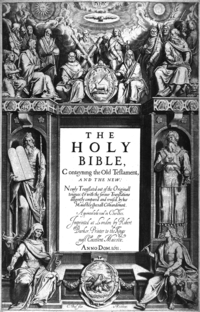Lamsa Bible
The Holy Bible from Ancient Eastern Manuscripts (commonly called the Lamsa Bible) was published by George M. Lamsa in 1933. It was derived, both Old and New Testaments, from the Syriac Peshitta, the Bible used by the Assyrian Church of the East and other Syriac Christian traditions.
| The Bible in English |
|---|
 Title page to the King James Version |
|
|
|
Lamsa, following the tradition of his church, claimed that the Aramaic New Testament was written before the Greek version, a view known as Aramaic primacy. This contrasts with the academic consensus that the language of the New Testament was Greek. Lamsa thus claimed his translation was superior to versions based on later Greek manuscripts. While Lamsa's claims are rejected by the academic community his translation remains the best known of Aramaic to English translations of the New Testament.[1][2]
Textual differences between Peshitta and Greek manuscripts
Some places in Lamsa's translation differ from the Greek texts used as the basis of other English-language Bibles.
Matthew 27:46
An example is found in Matthew Matthew 27:46, where Lamsa has "My God, my God, for this I was spared!" where the Greek text has "My God, my God why have you forsaken me."
And about the ninth hour
Jesus cried with a loud voice, saying,
Eli, Eli, lama sabachthani?
that is to say,
My God, my God, why hast thou forsaken me?
This is rendered in Lamsa's translation:
And about the ninth hour,
Jesus cried out with a loud voice and said,
Eli, Eli lemana shabakthan!
My God, my God, for this I was spared!
Though in fact the Peshitta does not have four lines in this verse. The 1905 United Bible Societies edition by George Gwilliam of the Peshitta in Syriac[3] contains only three lines, the Aramaic "Eli, Eli,.. " (ܐܝܠ ܐܝܠ) etc. not being given twice:
ܘܠܐܦ̈ܝ ܬܫܥ ܫܥ̈ܝܢ
ܩܥܐ ܝܫܘܥ ܒܩܠܐ ܪܡܐ ܘܐܡܪ
ܐܝܠ ܐܝܠ ܠܡܢܐ ܫܒܩܬܢܝ
This verse in Greek manuscripts states that from the Cross, Jesus (quoting Psalm 22:1) cried out, 'My God, My God, why hast Thou forsaken Me?' (See Matthew 27:46) proponents of the priority of the Aramaic New Testament such as the Nestorian Church claim this verse is a mistranslation into Greek.
Matthew 19:24
Some scholars of the Peshitta and the Greek New Testament claim that in Matthew 19:24 as the Aramaic word for 'camel' is written identically to the word for 'rope.' an error occurred due to the translator's limitations when the original scrolls were being transferred into Greek. This would mean Matthew 19:24 commonly translated as, 'It is easier for a camel to go through the eye of a needle than for a rich man to enter into the Kingdom of God.' Would read 'rope' instead of 'camel'. To support this they claim that rope, is much more in keeping with the imagery of a needle, and that it is probably what Jesus said, and what was originally recorded. Saint Cyril in his commentary on the Holy Gospel according to Luke (Luke 18:25) says that camel is the term used by those versed in navigation for a thick rope, thereby both stating that the term camel is the right one and that its meaning is that of a rope and not the animal. This suggests the Lamsa 'rope' translation is the more accurate "meaning" translation and 'camel' is the more accurate 1st century "slang" translation.
Criticism
The Assyrian tradition has been widely refuted by scholars of both the New Testament and the Peshitta. Another concern is that the 1905 United Bible Societies Aramaic New Testament, based on the editions of Philip E. Pusey, George Gwilliam and John Gwyn, with which Lamsa's sources are largely common, are a late form of the Aramaic text which reveals nothing of the early stages of the Peshitta's development.[4] This translation is better known as the Lamsa Bible. He also wrote several other books on the Peshitta and Aramaic Primacy such as Gospel Light, New Testament Origin, and Idioms of the Bible, along with a New Testament commentary.
References
Lamsa, George. The Holy Bible from Ancient Eastern Manuscripts. ISBN 0-06-064923-2.
- William E. Paul English Language Bible Translators 1476610231-2009 Page 135 "His next translation was The Book of Psalms According to the Eastern Version, Translated from Original Aramaic Sources (Philadelphia, ¡939). The following year he issued The New Testament According to the Eastern Text, Translated from Original Aramaic Sources (Philadelphia, ¡940). With the financial backing of another benefactor, Mrs. Outerbridge, of Chestnut Hill, Pennsylvania, Lamsa also set about to translate the Old Testament. He eventually published the complete Bible as ..."
- The Book We Call the Bible 0982536755 Advance Ministries - 2010 - 11 There is no substantial evidence of this, however, so the 12 claims of those like James Murdock, a translator of the Peshitta (a Syriac version of the New Testament) and George Lamsa, the publisher of The New Testament, According to the Eastern Text, are largely ignored by most Christian scholars. Lamsa's testament is named on the title page as "The Lamsa Bible," and makes the claim that it was directly translated from the "original Aramaic sources." He holds that the Peshitta is ..
- ܟܬܒܐ ܩܕܝܫܐ ܗ ܟܬܒܐ ܕܕܝܬܩܐ ܥܬܝܩܬܐ ܘܢܝܕܬܐ. United Bible Societies. 1979. p. 41 (NT).
- The text of the New Testament: an introduction to the critical ... Page 194 Kurt Aland, Barbara Aland - 1995 "The text printed in the London edition prepared by Philip Edward Pusey and George Henry Gwilliam is obviously a late form ie, the text which achieved common acceptance. It reveals nothing of the early stages of the Peshitta's development which is a matter of controversy."
External links
- Lamsa Bible Download
- George M. Lamsa: Christian Scholar or Cultic Torchbearer?, by John P. Juedes